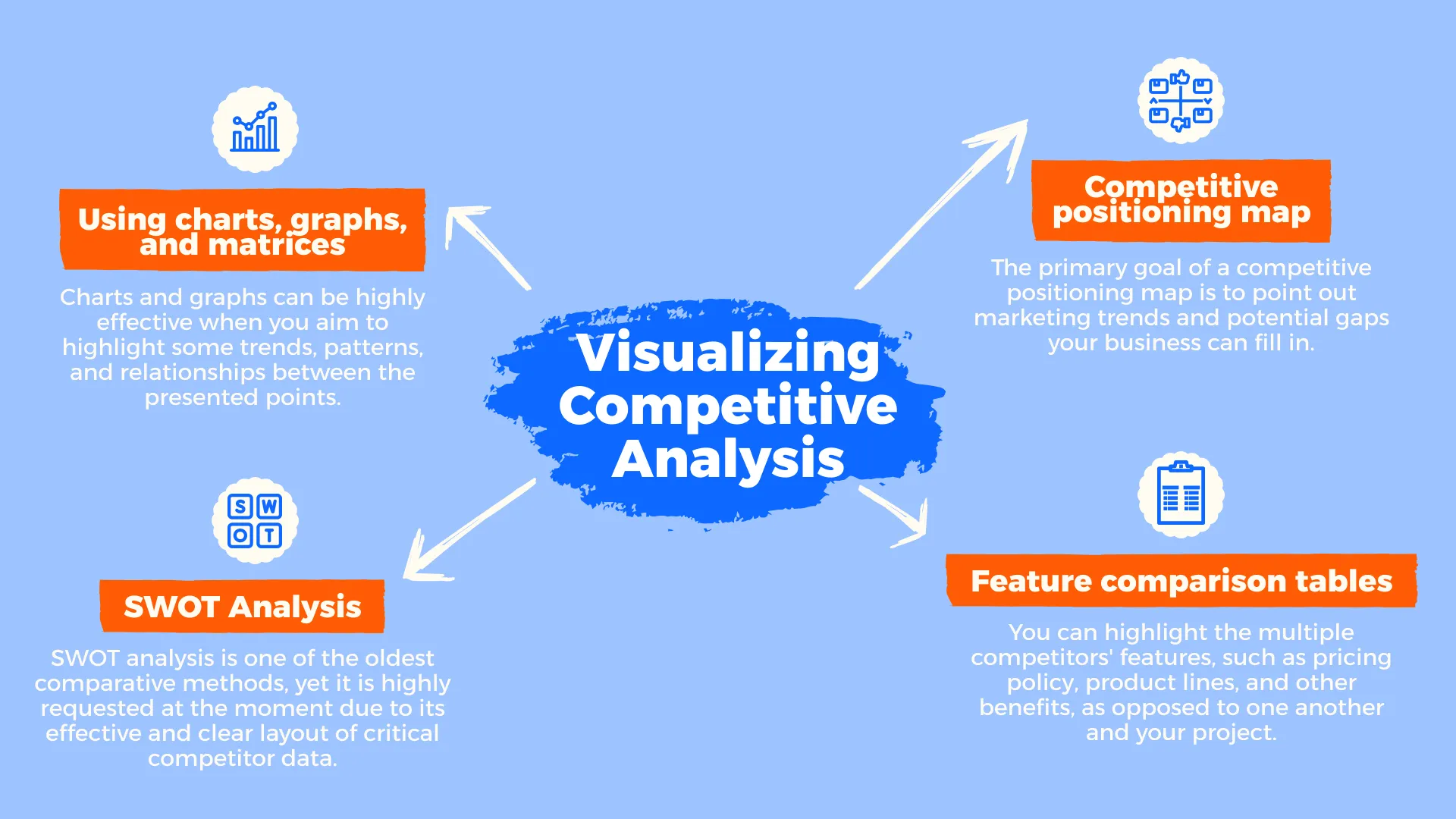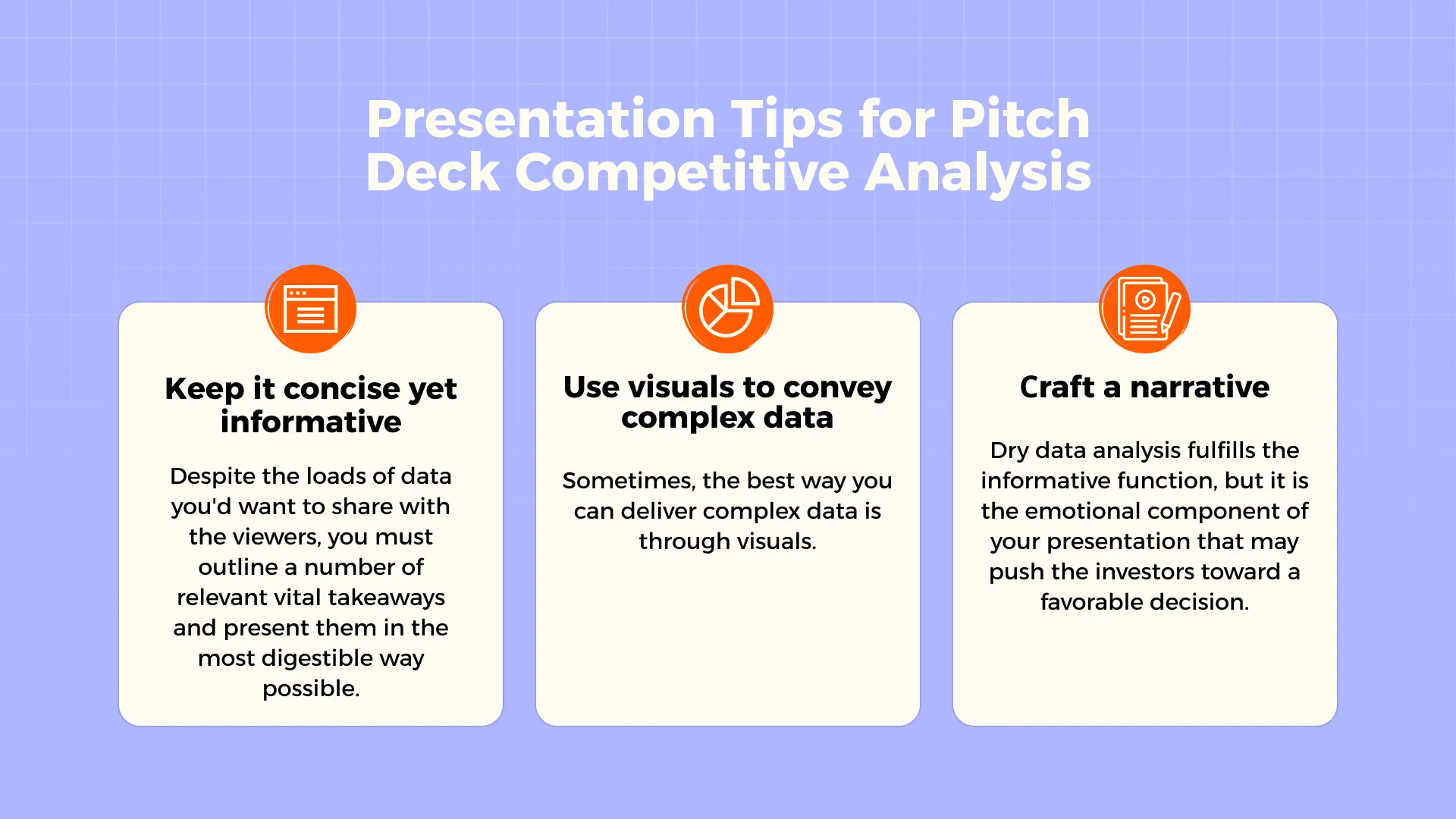
How To Create A Competitive Analysis In A Pitch Deck: A Comprehensive Guide

Launching a 99% unique and successful startup is a dream of every vendor. However, the chances are that no matter the problem your business addresses, there's someone else doing the same. Your goal here is to spot your rivals and outrun them. As you seek out necessary funding for your adventures, a quality pitch deck competition slide is that one opportunity to seal the deal and venture into the open sea.
Some companies perceive the notion of competition as an annoying obstacle. Yet, it can become your golden ticket. Think of Airbnb or Uber as opposed to classic industries. They faced paramount challenges but figured out how to get ahead of the competition and revolutionize those fields.
A well-designed pitch deck competition slide can become your Ace of Spades. As you showcase your understanding of the market, its dynamics, rivals' strengths and weaknesses along with the potential ways of overcoming every pitfall, you will gain investors' trust and confidence.
Considering the pivotal role of competitive analysis in your pitch deck, today we'll discuss the critical components of the competition slide, effective tips, and the common mistakes to avoid while working on your presentation.
Care to join our quest for success?
Understanding Competitive Analysis
Before we delve a little deeper into the pool of competitive analysis, you may want to learn what the notion stands for from the perspective of a successful investor pitch deck.
Definition of competitive analysis in the context of a pitch deck
A competitive analysis is a detailed research and evaluation of the existing competition in the niche, market, or industry you relate your project with. Such an in-depth examination helps you discover your rivals' main strengths and weaknesses. With such insights, you can outline your advantages, mark potential opportunities, locate the flaws in competitors' strategies, and overcome those.
Expert presentation deck design services, imagine a business as a ship navigating the ocean and the competitive analysis as a compass that leads to the destination, avoiding rocks and riffs. A competitive slide would be the roadmap you can share with the investors.
Why does it matter to investors and stakeholders?
Potential investors and stakeholders must determine your startup's unique and worth of investment to fund it. Once you prove that you understand the marketing challenges, highlight palpable opportunities, and present effective means of getting ahead of the competition, you will emphasize your market awareness, creativity, commitment, and proactive approach.
Moreover, a well-presented competitive analysis speaks about your ability to think in perspective, strategize, and potentially adapt to dynamic shifts in the market. Simply put, a competitive analysis slide usually highlights your project's potential and long-term success.
Preliminary Research: Gathering Data
Now that you know how table-turning the competitive analysis can become in your funding venture, you will wonder where to acquire reliable competition data.
Where to find data on competitors?

There's more than a single available source to collect data from.
Industry reports
WhitePage experts suggest that you start with marketing trends and industry forecasts. You can use Statista or IBISWorld for this purpose.
News Resources
Once you outline your primary rivals, you may want to ensure you are notified about what they are up to on time. Following their news stories would help you gain the necessary information. You can set up Google Alerts for some competitors' names so you don't miss a thing.
Competitor websites
Don't be afraid to browse through the competitors' websites. You can learn more about their strategies, services, pricing models, and unique selling propositions(USPs) from the main source.
Third-party resources
The company's promise does not always coincide with the basic user needs. That is why it is worth paying attention to customer review services. You can improve your proposition by learning about the competitors' flaws. Platforms like G2 or Trustpilot can come of immense use.
Social media
Make sure you follow your competitors on social media. It will keep you updated on any shifts and changes the rivals are up to.
Financial reports
To access any public company's financial records, such as growth rates, all it takes is to track their SEC(Securities and Exchange Commission) fillings.
The importance of using recent and relevant data
As you gather data for your competitive analysis in a pitch deck, double-checking its accuracy is vital. Otherwise, you may end up with a flawed strategy. The modern market is highly changeable. Thus, relevant data will help you embrace and adapt to all the shifts and trends, not to mention that inaccurate data will undermine your pitch's credibility, ruining the trust and connection with the investor pool.
Identifying Key Competitors
Not all the businesses involved in the industry you represent are equally worth your time and effort. To create the best pitch decks you must be able to differentiate between primary and secondary rivals. Let's try to figure out how to succeed with the goal together, shall we?
Criteria for identifying direct vs. indirect competitors
You can base your competitor research on three basic criteria:
- Products or services offered
- Market approach
- Target audience
1. Your direct competitors will offer the same or closely related services, like McDonalds and Burger King. At the same time, indirect competitors may present different products, but they will aim at the same customer demand.
2. In terms of market approach, direct competitors usually share the same location and potential distribution channels that you use. While indirect competitors often use different channels and may even cover the global market, they may still present a similar solution to the one you plan to launch.
3. Finally, direct competition covets the same consumer segment, and indirect competition affects different segments, but both propositions overlap at one point or another.
Tools and resources for competitor identification
No matter the use of theoretical knowledge in competitor identification, there are practical means that can make your competitive landscape slides twice as effective.
- Sprout Social – track your competitor's performance on social media to optimize your marketing strategy.
- Kompyte – track updates from the competitors' websites, review sites, ads, and social media within a single dashboard.
- SEMrush – analyze competitors' online strategies, identify direct and indirect competition, and improve your SEO approach.
Breaking Down the Competitive Landscape
While working on your success-driven pitch deck competitive landscape slide, you must understand the environment of your niche or industry. Such knowledge will help you locate all the players on the map along with their strengths and weaknesses so that you can determine where your best chances lie.
Market positioning and segmentation
Simply put, market positioning establishes an image or identity that the users will subconsciously connect with your business. As you research your competitor base's positioning, you can develop a unique representation that sets you aside from the rest.
As for segmentation, every company tends to cover a specific target audience. However, it is twice as easy and effective to reach out to the desired audience when you divide it into smaller categories – segments – grouped by such criteria as demographics, location, psychographics, etc.
Often, go-to-market strategy services use competitors' marketing position and segmentation to point out lucrative opportunities along with potential loopholes to implement into the strategy.
Understanding the strengths and weaknesses of each competitor
No two competitors are ever the same. Thus, you must take time and define each separate competitor's strength range and the weakness pool. Understanding which methods are more effective, you can use them to enhance and promote your campaign.
Analyzing competitor product features, USPs, and value propositions
There are a few major aspects to pay increased attention to:
- Market share – the competitors' grasp over the market and industry.
- Product features – innovations and unique offers that a competitor presents will help you define your weak points.
- Value proposition – each company chooses a certain way to deliver their goods to the client. Whether through pricing, convenience, or experience, you can figure out which pays off best in the target industry.
- USP – since each business labels its products as unique and one-of-a-kind, you can mark all its advantages and come up with something even more remarkable.
Visualizing Competitive Analysis

Along with the quality of the gathered data, you must be aware of how to present it in the pitch deck competitor's slide to have the most desirable effect on the viewers. There are a few practical ways of visualizing competitor analysis.
Using charts, graphs, and matrices
Charts and graphs can be highly effective when you aim to highlight some trends, patterns, and relationships between the presented points. For example, you can use a pie chart to reflect the segments or preferences of your competitors, while a line chart will indicate their revenue growth or decrease at one point or another.
At the same time, comparison matrices can showcase your ranking, USPs, etc., as opposed to the competitor so that you can present the areas you plan to improve when it comes to production.
SWOT Analysis: Strengths, Weaknesses, Opportunities, and Threats
SWOT analysis is one of the oldest comparative methods, yet it is highly requested at the moment due to its effective and clear layout of critical competitor data. According to the analysis, you should organize your information presented in the competition slide in a pitch deck in the following way:
- Strengths – internal advantageous factors such as an experienced team or product quality.
- Weaknesses – internal disadvantageous factors such as limited budget.
- Opportunities – promising external factors such as current trends or high demand.
- Threats – risk-charged external factors such as emerging competition or supply cost increase.
Competitive positioning map
The primary goal of a competitive positioning map is to point out marketing trends and potential gaps your business can fill in. The notion of the graph is pretty basic. All it takes is to draw a plot graph with an x-axis and a y-axis. Use one of the axes to showcase the price, from low to high, and the other to define the product quality – again from low to high.

Feature comparison tables
In case you are looking for the most concise way to present your pitch deck competitive landscape, a comparison table comes of great use. You can highlight the multiple competitors' features, such as pricing policy, product lines, and other benefits, as opposed to one another and your project. Such a layout suffices for better information perception so that an investor can make a suitable decision.

Competitive Insights into Your Strategy
Various competitor insights can strengthen your business strategy if you know how to present them correctly.
Use competitive data to refine your business model
Your competitors' weaknesses are your strengths. That's a statement. Once you notice any obvious gaps in your rivals' strategies – you can do your best to fill them out. However, you can use their strong point to your benefit as well. For instance, you can exploit a successful pricing model to tune your financial criteria to. Moreover, you can even improve it a little to outperform the competition.
Address potential investor concerns preemptively
A detailed competitor analysis will ensure that you can answer potential investors' questions before they even ask them. As you tell your story, emphasize how you plan to fill in the discovered market gaps. Don't be afraid to bring up the challenges that you may face on the road to success. Startups that act proactively in the face of potential threats ensure potential investors of their competence and trustworthiness.
Highlight your unique value proposition in contrast to competitors
Even if you analyze the pool of direct competitors, it is possible to find features that bring your product ahead of the game. You can point to the supreme quality of your product, innovative approach, effectiveness against user pain points, etc. By declaring your market positioning, you will show the investors potential revenue growth opportunities, which will solidify your business model.
Presentation Tips for Pitch Deck Competitive Analysis

One of the significant requirements of a successful pitch deck competitive advantage slide is that it remains as clear, consistent, and concise as possible.
Keep it concise yet informative
Despite the loads of data you'd want to share with the viewers, you must outline a number of relevant vital takeaways and present them in the most digestible way possible. Don't shy away from the use of good old bullet points. They suffice visual appeal along with reflecting the most critical information through their orderly structure.
Use visuals to convey complex data
Sometimes, the best way you can deliver complex data is through visuals. We've discussed the value of pie charts, line graphs, and infographics already. What's left to add is that you can use such handy tools as Microsoft Power BI, or Infogram.
The importance of storytelling: craft a narrative around your competitive edge
Dry data analysis fulfills the informative function, but it is the emotional component of your presentation that may push the investors toward a favorable decision. That is why you have to try to combine both and present a compelling story out of your competitive narrative.
Here's a simple technique you can apply to your case:
- Set the scene and describe the market without your project in sight – aka Before.
- Introduce your company along with its impact on the scene – Transformation.
- Explain how competitive analysis affected your company – aka After.
- Present your unique position along with all the advantages at hand – Differentiation.
- Based on the insights you have gained, you can proclaim your future success – aka Future Vision.
- Don't forget to enrich your story with a personal touch through case studies, fun facts, jokes, and related visuals.
By combining concise information, impactful visuals, and a compelling narrative, your pitch deck's competitive analysis becomes not just a presentation of facts but a captivating story that engages investors and showcases your edge in the market.
Common Mistakes and How to Avoid Them
A single mistake can ruin all the hard work you've put into your presentation. So, you should try to steer clear of these common errors when working on your competitive analysis.
Avoid informational overloading
Excess flow of information may have an overwhelming and distracting effect on your viewers. Thus, WhitePage experts advise you to focus only on relevant information. You can present different reports, valuable insights, along with high-impact data.
The danger of underestimating your competitors
An in-depth research of each of your competitors will help you ensure that you don't have any false impressions. Thus, even if you analyze your direct competitors, it is a great idea to consider indirect ones as well. Try not to concentrate solely on their weaknesses. Very often, these are their strengths that pose more threats.
Stick to an objective and unbiased analysis
A single source of information, no matter how credible, won't be enough to build an objective analysis of the competition. Thus, you should use different sources and trustworthy reports instead of various speculations, assumptions, and separate opinions.
Tools and Software for Professional Competitive Analysis
A list of reliable tools can simplify your pitch deck competitor analysis tremendously.

Popular tools for data gathering, visualization, and analysis
Crunchbase is an intelligence platform that can offer you a range of up-to-date information on different public and private companies.
Features:
- Financial insights
- Key performance metrics
- Market shifts and trends
- Competitor investor data
Tableau is a visualization platform featuring access to multiple data sources with unrestricted access to various presentation formats.
Features:
- Simple and user-oriented interface
- Multiple integrations
- Flexible and secure
- Advanced visualization
SEMrush is an all-in-one tool to gain up-to-date marketing insights and track your competitors' online presence.
Features:
- Traffic analysis
- Organic research
- Social media tracker
- Advertising research
Pros and cons of popular competitive analysis tools
Despite their usefulness, most of the analytical tools come with a set of advantages and potential drawbacks.
SEMrush
Pros
- Free plan available
- Professional SEO research tools
- Excellent support
- Guides and tutorials provided
Cons
- Steep pricing policy
- Requires field expertise
- Lacks offline competitor insight
Crunchbase
Pros
- Quality data filtering
- Effortless data exporting
- Funding information accessible
Cons
- Outdated reports occur
- Premium access to some data is required
Tableau
Pros
- High performance
- Low cost
- Easy to use
- Mobile-friendly
Cons
- No auto-refreshing is available
- SQL knowledge required
Conclusion
The better you understand your competition, the easier it will be to get ahead of it. A professional pitch deck competitive analysis will help the investors understand that you are fully aware of the threats and challenges that your rivals pose. Yet, you know how to use them to strengthen your own strategy. Besides, it will help you gain clarity in your startup and get ahead of the game.
Along with all the critical aspects of comparative analytics, practical tips, and potential pitfalls, you must remain aware of the marketing dynamics. The competitive landscape is ever-evolving, and you may require professional assistance to keep up with all the shifts and changes.
Feel like you need a helping hand to hone your pitch deck and propel your business ideas? Contact us and let the Whitepage pitch deck design agency transform your vision into a breathtaking presentation!
Talk to a presentation design expert now!
Let's Talk
FAQ

Read more




.avif)

.webp)
.webp)




































